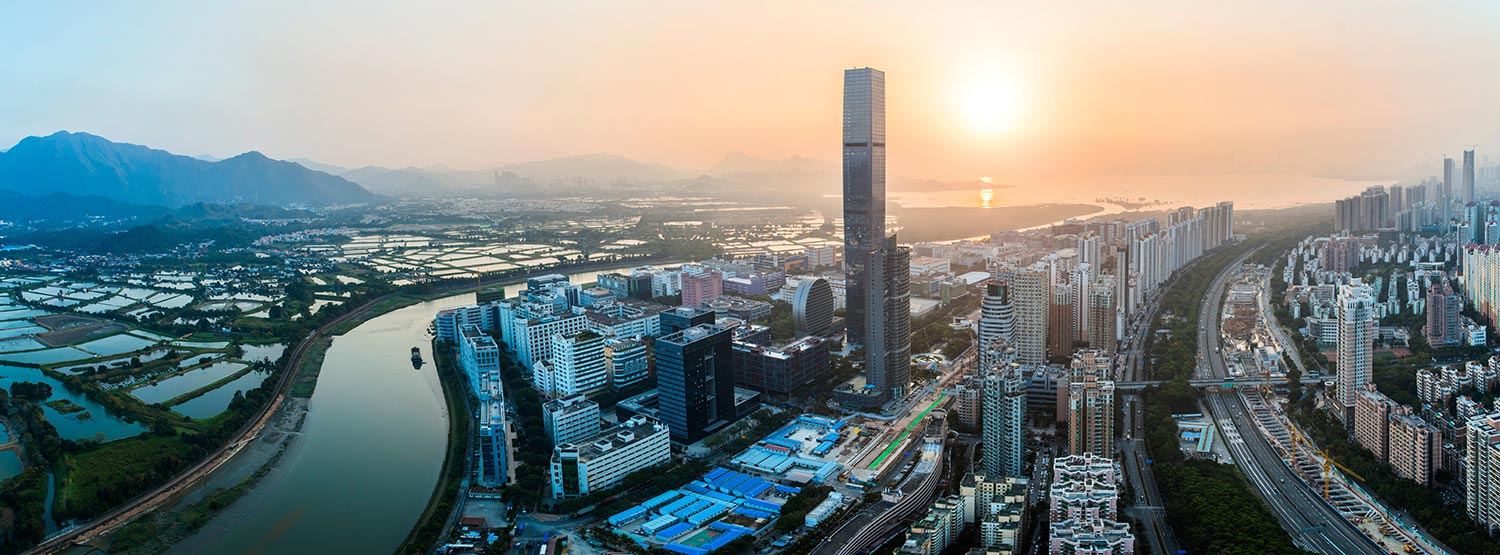Shenzhen

- Shenzhen, also known as "Pengcheng" (the City of Giant Eagle), is a coastal city in South China, adjoining Hong Kong. It is an "early and pilot implementation" area under the country's reform, opening-up and modernisation.
- The Shenzhen Special Economic Zone was established in August 1980. In March 1981, Shenzhen was promoted to a sub-provincial city. In July 1992, Shenzhen was granted with legislative power for its special economic zone.
- Shenzhen has developed a convenient and efficient integrated transport system. Beijing-Kowloon Through Train, Guangzhou-Shenzhen-Hong Kong Express Rail Link and Xiamen–Shenzhen railway form a national railway node at Shenzhen. Shenzhen Metro consists of twelve lines, of which the Line 4 and 10 connects with Hong Kong's mass transit railway network. Shenzhen has a well-developed highway network connecting Shenzhen to other cities of the Pearl River Delta. As at end 2020, passenger airlines operating at the Shenzhen Bao'an International Airport reached 137 cities and cargo airlines reached 47 cities in the world.
- Shenzhen has boundary checkpoints covering land, sea and air travel. It is the city with the largest number of checkpoints, largest inbound/outbound passenger flow and vehicular flow in the Mainland. Among all, Lo Wu Checkpoint is one of the busiest Chinese land passenger checkpoints, Huanggang Checkpoint offers 24-hour clearance, Futian/Lok Ma Chau Checkpoints connects directly to Shenzhen metro and Hong Kong mass transit railway respectively, Shenzhen Bay and West Kowloon Station Checkpoints adopts "colocation" arrangement.
- The four pillar industries of Shenzhen are advanced technology, modern logistics, financial services and cultural industry. Shenzhen focuses on the development of seven emerging industries of strategic importance, namely biotechnology, Internet, new energy, new materials, cultural and creative industries, new generation information technology, as well as energy conservation and environmental protection, plus future industries on life and health, marine, aerospace and aviation, robots, wearable devices, and smart equipment.
Major Development Areas
- National level: Qianhai Shenzhen-Hong Kong Modern Service Industry Cooperation Zone, Shenzhen High-Tech Industrial Development Zone, Shenzhen Bonded Zone, Yantian Port Bonded Logistics Park, Shenzhen Export Processing Zone, and Shenzhen Qianhaiwan Free Trade Port Area
- The Central Government promulgated on 6 September 2021 the Plan for Comprehensive Deepening Reform and Opening Up of the Qianhai Shenzhen-Hong Kong Modern Service Industry Cooperation Zone (Qianhai Plan). According to the Qianhai Plan, the area of the Qianhai Shenzhen-Hong Kong Modern Service Industry Cooperation Zone will be increased significantly from 14.92 square kilometres to 120.56 sq km. It also stresses the promotion of high-level opening up in Qianhai, the fostering of innovative development of modern service industries, and the acceleration of the building of a system of modern services that is compatible with Hong Kong and international standards.
- The establishment of the China (Guangdong) Free Trade Pilot Zone was officially approved by the State Council on 31 December 2014, which comprises three areas totaling 116.2 square kilometres. Qianhai & Shekou Area of Shenzhen was officially launched on 27 April 2015. The planned area is 28.2 square kilometres, divided into Qianhai Block (15 square kilometres, i.e. Qianhai Shenzhen-Hong Kong Modern Service Industry Cooperation Zone) and Shekou Block (13.2 square kilometres). The Overall Development Plan on Hong Kong/ Shenzhen Cooperation on Modern Service Industries in Qianhai Area was endorsed by the State Council in August 2010. It positioned the 15-square-kilometre Qianhai Shenzhen-Hong Kong Modern Service Industry Cooperation Zone as a demonstration area of innovation and cooperation of Guangdong-Hong Kong modern service industry, focusing on the development of finance, modern logistics, information services, technology services and other professional services.
- There are a number of preferential policies for Hong Kong people and enterprises in Qianhai, including:
- implementation of cross-border Renminbi (RMB) lending;
- imposition of 15% enterprise income tax for eligible Hong Kong enterprises;
- rebate of personal income tax paid in excess of 15% of taxable income from the Shenzhen municipal government to eligible Hong Kong talents in Qianhai;
- dedicated funding programme on innovation and entrepreneurship for eligible Hong Kong enterprises, and funding programme for Hong Kong-invested headquarters in Qianhai;
- housing quota for eligible Hong Kong enterprises and talents;
- designation of Qianhai as a pilot area for Hong Kong and Guangdong law firms operating in the form of partnership association;
- pilot housing construction projects in which Hong Kong's construction and related engineering enterprises and professionals are allowed to provide services in Qianhai; and
- an exemption from the employment permit requirement for Taiwan, Hong Kong and Macao residents in Qianhai.
- As of October 2020, 19 land parcels were sold to Hong Kong enterprises, with an area of 39.55 hectares, accounting for 43.2 percent of the land sold in Qianhai for commercial uses. A total of 211 Hong Kong entrepreneurial teams had landed in Qianhai Shenzhen-Hong Kong Youth Innovation and Entrepreneur Hub (E Hub) with incubation support.
Contact Us
Leave your details and we'll be in touch.